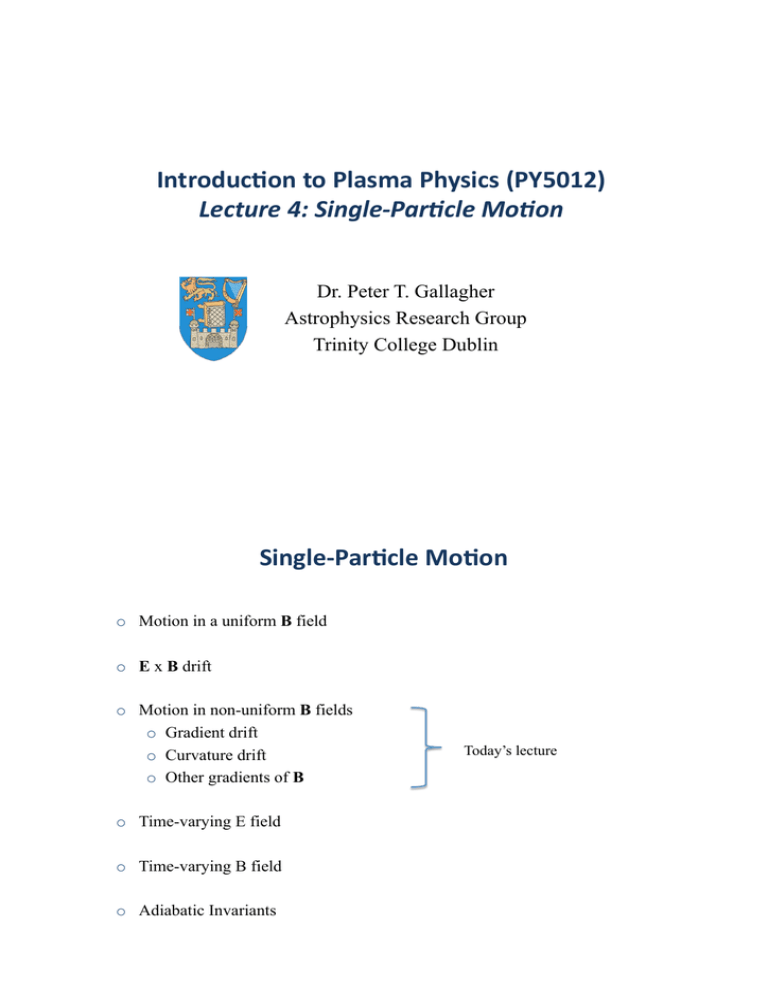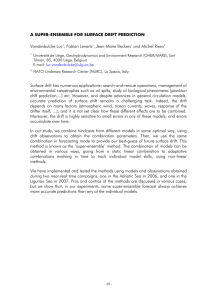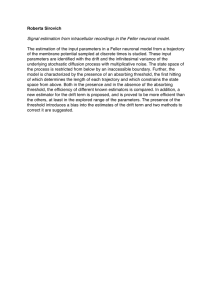Lecture 4: Single-Particle Motion II
advertisement

!"#$%&'()%"*#%*+,-./-*+01.2(.*3+456789* !"#$%&"'()'*+,-."/01&2#."'3424,' Dr. Peter T. Gallagher Astrophysics Research Group Trinity College Dublin :2";,<=+-$)(,<*>%)%"* o Motion in a uniform B field o E x B drift o Motion in non-uniform B fields o Gradient drift o Curvature drift o Other gradients of B o Time-varying E field o Time-varying B field o Adiabatic Invariants Today’s lecture ?$2@.*2"*'"2A%$/*-"&*"%"='"2A%$/*B<,&.* o In last lecture, solved equations of motion for particles in uniform B and E fields. o Showed that drift of guiding-centre is: vE = E"B B2 which can be extended to a form for a general force F: ! vf = o In a gravitation field for example, 1 F"B q B2 vg = m g"B q B2 ! o Similar to the drift vE, in that drift is perpendicular to both forces, but in this case particles of opposite charge drift in opposite direction. ! o Uniform fields provide poor descriptions for many phenomena, such as planetary fields, coronal loops, tokamaks, which have spatially and temporally varying fields. +,-./-*(%"B"</<"#*2"*C%D-/-D* ?$2@.*2"*"%"='"2A%$/*/-;"<)(*B<,&.* o Particle drifts in inhomogeneous fields are classified in several ways. o In this lecture, consider two drifts associated with spatially non-uniform B: gradient drift and curvature drift. There are many others! o As soon as introduce inhomogeneity, too complicated to obtain exact solutions for guiding centre drifts. o Therefore use orbit theory approximation: o Within one Larmor orbit, B is approximately uniform, i.e., the typical length-scale, L, over which B varies is such that L >> rL.=> gyro-orbit is nearly a circle. E$-&=F*?$2@** o Assume lines of forces are straight, but their density increases in y direction (see figure below from Chen, Page 27). y -direction o Gradient in |B| causes the Larmor radius (rL = mv/qB) to be larger at the bottom of the orbit than the top, which leads to a drift. o Drift should be perpendicular to grad B and B and ions and electrons drift in opposite directions. E$-&=F*?$2@** o Consider spatially-varying magnetic field, B = ( 0, 0, Bz(y) ). i.e., B only has zcomponent, the strength of which varies with y. o Assume that E = 0, so equation of motion is F = q(v " B) o Separating into components, Fx = q(vy Bz ) F ! = "q(v B ) y x z (4.1a) (4.1b) Fz = 0 o Now the gradient of Bz is ! dBz Bz B " << z dy L rL dB => rL z << Bz dy o This means that the magnetic field strength can be expanded in a Taylor expansion for distances y < rL: dB ! Bz (y) = B0 + y z + ... dy ! E$-&=F*?$2@** o Expanding Bz to first order in Eqns. 4.1a and 4.1b: " dB % Fx = qvy $ B0 + y z ' dy & # " dB % Fy = (qvx $ B0 + y z ' dy & # (4.2) o Particles in B-field travelling about a guide centre (0,0) have a helical trajectory: x = rL sin("c t) y = ±rL cos("c t) ! o The velocities can be written in a similar form: vx = v"cos(#c t) vy = ±v"sin(#c t) ! % dB ( o Substituting these into Eqn. 4.2 gives: Fx = "qv#sin($c t)' B0 ± rL cos($c t) z * dy ) & ! % dB ( Fy = "qv# cos($c t)' B0 ± rL cos($c t) z * dy ) & ! E$-&=F*?$2@** o Since we are only interested in the guiding centre motion, we average force over a gyroperiod. Therefore, in the x-direction: % dBz ( Fx = "qv#'B0 sin($c t) ± rL sin($c t)cos($c t) * dy ) & o But < sin(!ct) > = 0 and < sin(!ct) cos(!ct) > = 0 => <Fx> = 0. ! o In the y-direction: % dBz ( Fy = "qv#'B0 cos($c t) ± rL cos2 ($c t) * dy ) & qv r dB = ! #L z (4.3)! 2 dy where < cos(!ct) > = 0 but < cos2 (!ct) > =1/2. ! E$-&=F*?$2@** o In general, drift of guiding-centre is vf = o Subing in using Eqn 4.3: v "B = ! 1 F"B q B2 1 Fy yˆ # B z zˆ q Bz2 =! v$ rL dBz xˆ 2Bz dy o So +ve particles drift in –x direction and –ve particles drift in +x. ! o In 3D, the result can be generalised to: 1 B $ "B v "B = ± v# rL 2 B2 Grad-B Drift o The ± stands for sign of charge. The grad-B drift in in opposite directions for electrons and ions and causes a current transverse to B. ! E$-&=F*?$2@** o Below are shown particle drifts due to a magnetic field gradient, where B(y) = z Bz (y). Page 31 of Inan & Golkowski. o Consider rL = mv/qB. Local gyroradius is large where B is small and visa versa which gives rise to a drift. Note also that charge determines direction of drift. E$-&=F*?$2@G*+,-"<#-$1*H2";*I'$$<"#* o Gradient drift is responsible for current in inner parts of planetary magnetospheres. o Approximate field is a dipole: µ 0 2m cos(# ) 4" r 3 µ 2m B# = 0 3 sin(# ) 4" r Br = ! o In equatorial plane, Br = 0 and B" = B0 / r3. There is therefore a positive gradient in B" directed radialy outwards. o There is therefore a grad-B drift perpendicular to B and grad-B, which produces a ring current circulating about a planet. E$-&=F*?$2@G*+,-"<#-$1*H2";*I'$$<"#* o Right: Ring current viewed from north pole with NASA’s Image satellite. I'$J-#'$<*?$2@* o When charged particles move along curved magnetic field lines, experience centrifugal force perpendicular to magnetic field (Fig Inan & Golkowski, Page 34). o Assume radius of curvature (Rc) is >> rL o The outward centrifugal force is mv||2 Fcf = rˆ Rc o This can be directly inserted into general form for guiding-centre drift ! vf = 1 F"B q B2 mv||2 Rc " B => v R = 2 qRc B2 Curvature Drift ! o Drift is therefore into or out of page depending on sign of q. ! I'$J-#'$<*-"&*;$-&=F*&$2@* o Type of field configuration studied above – having curved but parallel field lines – will never occur in reality, since ∇䏙B # 0 for this field. o In practice, curved field lines will always be converging/diverging. Thus a curvature drift will always be accompanied by a grad-B drift. o Where ∇B is in the opposite direction to Rc, the grad-B and curvature drifts act in the same direction. o Right is a cross-section of a tokamak magnetic field. o Dashed lines are field lines. In the highlighed section, the field is lower at edge than in the centre. So curvature and gradient drift act in same direction - outwards for ions – so ions hit the vessel walls and are lost.



